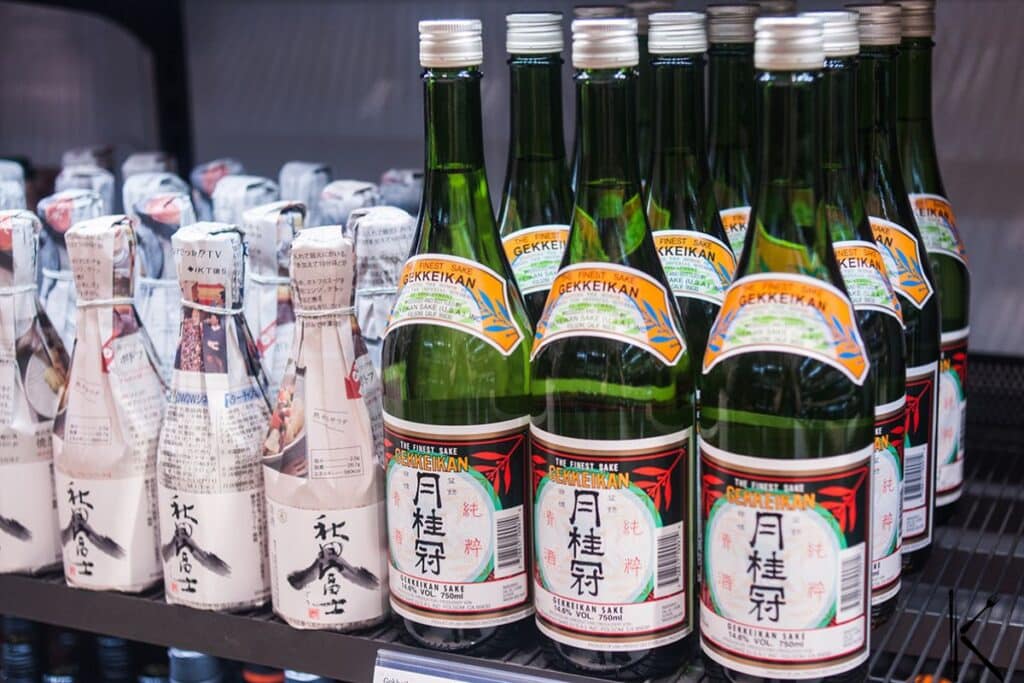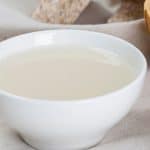In short, the best alternatives to sake include Mirin, Chinese Shaoxing wine (Chinese rice wine), dry sherry, Vermouth, etc. Each alternative has specific uses and flavors, making them suitable for various dishes.
If you’re planning on whipping up a Japanese feast, you’ll probably need some sake in the pantry.
This Japanese rice wine is an essential ingredient in Japanese cooking. It is used to tenderize meat, eliminate fish odors, and to add depth of flavor.
If your recipe calls for sake, and you can’t find it at your local grocery store, we’ve got you covered.
This guide will help you choose the best sake alternatives for the dish you are cooking. We’ll also give you some non-alcoholic options and tips on how to use each alternative.
Before we start, let’s look at what exactly sake is.
Drinking Sake vs Cooking Sake
Sake, otherwise known as Japanese rice wine, is made by fermenting polished white rice. Although it is called wine, the brewing process is more like that of making beer.
Drinking sake is often enjoyed at special ceremonies and has an ABV (alcohol by volume) content of 15 to 20%. The type of sake used for cooking (also referred to as ryourishu) is different since it contains a little less alcohol.
Unlike drinking sake, cooking sake can be made with lower-grade fermented rice and includes extra flavorings such as sugar, salt, and amino acids. This gives it a more unique flavor adding depth and umami to recipes.
If you were to use drinking sake for cooking, you would have to use double the amount to get the same flavor. This also means you would be adding a significant amount of alcohol to your dish.
Cooking sake is used in soups, stir-fries, marinades, rice dishes, and baking. It is also popular for marinades and minimizes odors when cooking items like fish.
Best Sake Replacement You Can Use
#1. Mirin
Mirin is an excellent substitute for sake since it is also a type of Japanese rice wine. Mirin is sweeter and has a lower alcohol content, but the flavor is fairly similar. The sweetness develops naturally through the fermentation process.
This ingredient is generally easier to find at general grocery stores, making it a more convenient option.
Mirin is available in three different types. Hon mirin has around 14% alcohol which makes it suitable in dishes that require long enough cooking for the alcohol to burn off. It is a good option to tone down the strong smell and flavor of fish dishes while adding flavor.
Shio mirin only has 1.5% alcohol, while shin mirin contains less than 1% alcohol. This makes them ideal as a seasoning.
Mirin can be combined with soy sauce for a delicious sweet and salty glaze that pairs wonderfully with meat, pork, tofu, stir fry, and vegetable or rice dishes. Mirin is also suitable for sushi, ramen, broth, and seafood.
Tip: When using any high-alcohol substitute, it is best to cook off some of the alcohol before adding it to the fish. Adding it too early will cause seafood to become rubbery and change the texture of the protein. Alternatively, use it as a marinade before cooking.
See more: Non alcoholic mirin substitute
#2. Chinese Shaoxing Wine (Chinese Rice Wine)
This rice wine is a Chinese form of sake. It is a staple in many Chinese recipes and is ideal for marinating meat, vegetable dishes, wontons, stew, sauces, and soup.
The Chinese cooking wine is not a drinking wine since it has been enhanced with other flavorings and has unrefined salty notes. Some brands do offer reduced salt versions.
When using Shao xing cooking wine as a substitution for sake, start with a little less than what your recipe calls for and add to taste if necessary.
#3. Dry Sherry
You can use either dry sherry or cooking sherry as a decent sake substitute to add depth of flavor to sauces, meaty stews, marinades, and soup.
This fortified wine is essentially a brandy and wine blend. Cooking sherry contains around 10% alcohol and has added preservatives and salt to enhance the flavor and prolong its shelf life. Cooking sherry is not suitable for drinking.
Related: Dry sherry substitute for cooking
#4. Vermouth
Vermouth is a versatile option to substitute sake since it comes in alcoholic and non-alcoholic versions as well as sweet red and dry white types.
This fortified grape wine is infused with herbs and spices and is a good choice for glazes, meat and chicken recipes, broth, soup, and sauces. Be mindful of choosing a sweet or dry type and how the flavors will work with the other ingredients in your dish.
If you are using dry vermouth, you can add a little granulated sugar if your glaze needs added sweetness.
Find all the details about vermouth shelf life and how to store it properly.
#5. White Wine
White wine is another good sake substitute since it is available in many different flavor profiles, including dry white wine, sweet wine, and somewhere in between. Wine won’t be an exact flavor replication, but it will add depth.
As with other alcoholic beverages, you need to ensure enough cooking time for the alcohol to cook off. Choose a wine that pairs best with the other flavor elements of your dish.
Related: Replacement for dry white wine
Best Non-Alcoholic Sake Substitutes
#6. Rice Wine Vinegar
Whether you need a non-alcoholic substitute for dietary reasons, religious reasons, or because the dish will not be cooked to burn off the alcohol, rice wine vinegar is a good substitute. You can use it successfully in cooked and uncooked recipes.
Despite its name, rice wine vinegar is not a wine and does not contain alcohol. It has a slightly sweet and sour taste which makes it delicious in dressings, marinades, and dipping sauces.
If you feel your sauce lacks sweetness, add a pinch of sugar to the rice vinegar when you replace sake.
#7. Balsamic Vinegar
Balsamic vinegar is dark in color with an astringent punch and slight sweetness. It is made by crushing, fermenting, and aging grape seeds and skins.
This is not an exact flavor match and will change the color of your dish entirely. It will, however, add delicious flavor complexity and is ideal for cooked and uncooked dressings, meaty marinades, sauces, stews, and vegetable dishes.
Related: Alternative to balsamic vinegar
#8. White Grape Juice
White grape juice has a similar color but a much sweeter flavor. Although it might not bring the same depth and richness, it does add fruity notes.
To counter the sweetness, you can add a dash of lemon juice when using it in dressings, sauces, and marinades.
The juice is easy to find pretty much anywhere, which makes it an effortless sake replacement.
#9. Apple Cider Vinegar
Where regular vinegar is made by fermenting grapes, apple cider vinegar is made by fermenting apples. It has a strong acidic taste but with a lovely fruitiness and slightly sweet flavor.
As with white grape juice, it offers a similar color but a different flavor when used as a substitute. This is best used in small quantities since it can easily be overpowering.
Use apple cider in marinades or dressings, and add a pinch of sugar if required.
See more: What can I use instead of apple cider vinegar?
#10. Kombucha
Made from black tea, sugar, and yeast, kombucha has become popular as a health drink. Commercial varieties are infused with fruity flavors and have added sweeteners.
These flavors will clash with delicate Japanese recipes, so if you use this as a substitute, opt for a plain type rather than a flavored or sweetened version. This will give you the acidity you’re after.
You can use kombucha in equal quantities as a replacement for sake. Although most commercial brands are free of alcohol, some versions may contain a very small percentage. Be sure to check the label if this is something that you need to avoid.
Learn more about kombucha’s shelf life and how to recognize the signs of spoilage.
#11. Distilled White Vinegar
Also known as spirit vinegar, this clear liquid undergoes an extensive oxidation process and has a very acidic taste. It is best used in very small amounts in sauces and marinades and is also commonly used in pickling.
FAQs
Can I use Aji-mirin as a substitute for sake?
Yes, you use Aji-mirin as a substitute for sake. Aji-mirin is a cheaper and lower-quality Japanese sweet rice wine. It has very little alcohol and tastes similar to regular mirin. Since it’s easier to find, cheaper, and has a well-balanced flavor, it makes a superb alternative in almost any recipe in equal quantities.
Should sake be refrigerated?
Yes, sake should be stored preferably in the refrigerator, especially after it’s been opened. Refrigeration helps maintain its flavor and quality over time.
Can sake go bad?
Yes, sake can go bad over time. Although sake is okay to use for a long time, the taste and quality will change over time. As it ages, it will develop a yellow color, and there may be small particles present in the liquid. Sake that smells bad, off, rotten, or that has an unpleasant taste should be thrown away.
Can cooking sake be frozen?
Yes, cooking sake can be frozen if you plan to store it for an extended period. Freezing can help preserve its flavor and prevent spoilage. Just remember that alcohol doesn’t freeze completely, so some separation might occur, but a gentle shake or stir upon thawing should bring it back to its original state.
What is a substitute for sake in chicken karaage?
A suitable substitute for sake in chicken karaage could be dry white wine or Chinese rice wine (Shaoxing wine). These options can provide a similar depth of flavor and help tenderize the chicken.
Conclusion
If you are cooking Japanese cuisine, it is very likely that your recipe will require sake.
If this is not something you generally keep in the pantry or you can’t find any in your local grocery store, another sweet Japanese rice wine is your next best option. Alternatively, there are a range of other ingredients, alcoholic and non-alcoholic, that you can use just as successfully.
Options containing alcohol, such as Chinese rice wine, dry sherry, vermouth, and white wine, should always be cooked to burn the alcohol. Non-alcoholic kinds of vinegar should be used in smaller amounts since their acidity can quickly overpower other flavors in the dish.
If you find your substitute a little too sweet, add a squeeze of lemon juice. On the other hand, you can always add a pinch more sugar for substitutes that are lacking the sweetness you desire.
The great thing about cooking and substituting ingredients is that you can tailor your recipe to exactly the way you prefer it. Happy cooking!
See more: Does sake expire?









